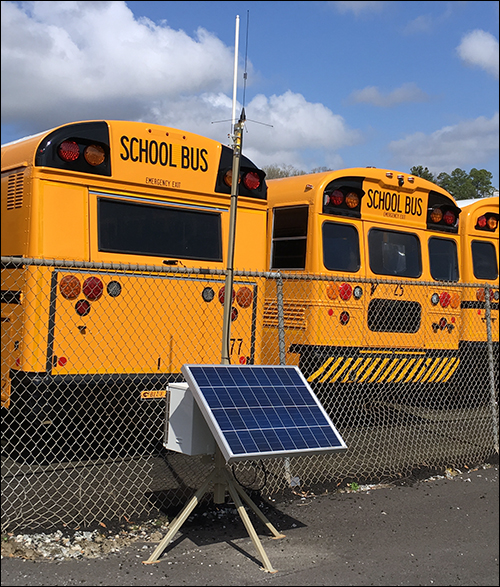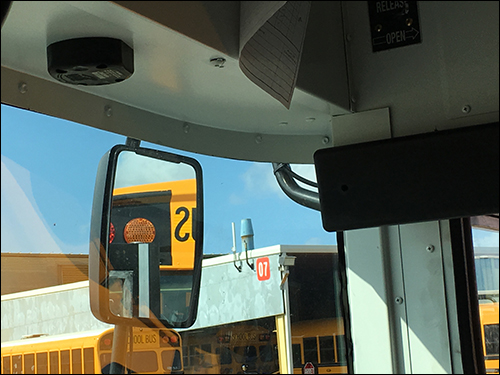U.S. bus manufacturer Blue Bird Corp. has deployed an active RFID-based solution that helps to manage the status and location of buses as they are driven through finishing processes following assembly, and then transported to dealers. “With this technology,” says Matt Walker, Blue Bird’s manufacturing engineering specialist, “we have been able to reduce the amount of time employees spend searching for buses, and can better ensure that the vehicles are processed in a timely manner.”
The system consists of active 433 MHz RFID tags and a reader network, as well as software to manage the collected reader data, provided by GuardRFID. In addition to tracking the general locations of buses throughout its 40-acre yard in Fort Valley, Ga., the company can pinpoint a particular vehicle’s exact location using an RFID-enabled golf cart that operators drive around the yard.
Blue Bird manufactures school buses, as well as security, ambulance and transit buses sold in North America and worldwide. Each bus is built to order, meeting the needs of each customer, such as a specific school district and state.
This makes for a complex manufacturing environment. In an effort to take full advantage of its assembly lines, equipment and workers, Blue Bird schedules a mix of product order types. For example, the bus company sometimes has an order under way that may not be required for several months, while at the same time another order that needs to be delivered within days—both of which are being handled on the same production line.
Buses undergo a series of finishing processes in multiple buildings—including front end alignment, air conditioning, water and road testing, pre-delivery inspections and certification—before being placed in staging for delivery. Previously, when individual buses needed to be moved to the next process, employees had to physically search for the vehicles in question. “It was no easy task,” Walker says. “Many of the buses look quite similar. In fact, we dedicated an entire job position simply for an individual to use paper and his brain to track the approximately 500 buses in the yard at any given time.”
To become more efficient, the company considered several technology-based solutions. It looked at offerings from nine vendors, each having a unique solution, including active RFID (operating at various frequencies), ZigBee, GPS fleet tracking and handheld radio-based solutions. One of Blue Bird’s requirements, however, was that the system would need to be easy to deploy, and would have reusable tags that could be removed from a bus when it left the yard, and then be attached to a new vehicle.
“The buses are made of steel construction, and the transmission of RF signals could prove challenging in the presence of all that metal,” says Walker. “Another concern was getting power to the system, as some buses can be located in sections of the yard which are considered remote areas, where cabling readers or gateways could be unfeasible and costly.”
According to Walker, the company chose the GuardRFID solution because the magnetic tags could be easily attached to buses. The tags could transmit a signal through a bus’s windshield and windows. The readers, in some locations, could be powered by solar power when necessary. The system was taken live in July 2017, following a month of testing.
GuardRFID’s solution consists of 14 wired readers and five Solar Powered Tag Readers (SPTRs) when running cable is not feasible. Of the wired readers, 12 include Ethernet and power connections, while two have only electric cables and use the yard’s Wi-Fi infrastructure. The five SPTRs utilize the Wi-Fi network, which GuardRFID provided. The software to manage the collected read data comprises GuardRFID’s Argus software, hosted on a local server, as well as the user-facing AllGuard software platform to display location data for Blue Bird’s employees.
Once a bus is assembled, an RFID tag is applied to the interior near the windshield. A worker uses the AllGuard software to input the tag’s ID number, then links that information to the vehicle number, body model and any unique features that would make the bus easier to find. This information is then displayed on the app via employee phones or tablets, letting them know which bus they are looking for.
As the assembled bus is driven around the facility, the tags emit a signal that is captured by the readers. “Depending on where within the yard the vehicle is located,” Walker explains, “granularity of location can be from 30 to 180 feet. When granularity is 30 feet, the system knows where a bus is located within about three parking spaces. In the more remote lots, fewer readers are deployed and location is less granular.”
In some cases, the company may require greater granularity, or a worker may need to retrieve a bus but might be unable to find its specific location, even with the AllGuard software information. In such a scenario, the employee can use the golf cart equipped with a GuardRFID exciter and a touch screen that displays read data. As he or she drives through the area in which the RFID system indicates the bus is located, the reader on the golf cart will seek the specific tag transmission. Once it receives that transmission, it displays the results on the screen so that the driver knows he or she has reached the intended bus.
“GuardRFID developed this golf cart system specifically for us,” Walker states. “The tags are programmed to beacon every ten minutes when motionless, and every 12 seconds when in motion.” The solution also consists of a GuardRFID reader and an exciter at the exit gate, to alert users to any tags not removed prior to bus delivery. If that hasn’t happened, the tag will respond to the exciter, thereby prompting an alert for gate personnel that a tagged vehicle is leaving the yard.
In some cases, buses are delivered to an outside vendor for processing. After a bus leaves through the gate, Walker says, workers can set the “tag in motion” alarm for the vehicle’s tag. When the bus returns, the tag immediately sends a notification so that Blue Bird knows one of its tagged buses has returned. In the future, Blue Bird intends to use the RFID tags to monitor work-in-progress completion during the off-line manufacturing process, by installing additional readers and exciters at processing buildings and in other areas.
“The results of the initial deployment indicated that many hours of labor time were saved,” Walker says. “When we put this system in, I had a lot of people coming to shake my hand and thank me. Finding buses was difficult for staff members who were onsite during the week, and it was especially challenging for weekend workers who entered the site with no idea where the buses were located. The system saves time for those workers.”




